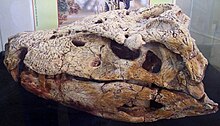Baurusuchidae
| Baurusuchids | |
|---|---|

| |
| Skull of Baurusuchus salgadoensis | |
| Scientific classification | |
| Domain: | Eukaryota |
| Kingdom: | Animalia |
| Phylum: | Chordata |
| Class: | Reptilia |
| Clade: | Archosauria |
| Clade: | Pseudosuchia |
| Clade: | Crocodylomorpha |
| Clade: | Crocodyliformes |
| Suborder: | †Notosuchia |
| Clade: | †Sebecosuchia |
| Branch: | †Baurusuchia Warren, 1968 |
| Family: | †Baurusuchidae Price, 1945 |
| Genera | |
Baurusuchidae is a
Genera
Several genera have been assigned to Baurusuchidae. Baurusuchus was the first, being the namesake of the family. Remains of Baurusuchus have been found from the Late Cretaceous Bauru Group of Brazil in deposits that are Turonian - Santonian in age.[3] In addition to Baurusuchus, five other South American crocodyliforms have been assigned to Baurusuchidae: Campinasuchus, Cynodontosuchus, Pissarrachampsa, Stratiotosuchus, and Wargosuchus. Cynodontosuchus was the first known baurusuchid, named in 1896 by English paleontologist Arthur Smith Woodward, although it was only recently assigned to Baurusuchidae.[4] Wargosuchus was described in 2008.[5] Cynodontosuchus and Wargosuchus are known only from fragmentary remains. Both genera are from the Santonian of Argentina.

A fourth genus, Stratiotosuchus, was assigned to Baurusuchidae in 2001. Pabwehshi is the youngest genus that has been assigned to Baurusuchidae, and is from the Maastrichtian of Pakistan.[6] It was named in 2001 but has since been reassigned as a basal member of Sebecia.[7]
A new genus, Campinasuchus, was assigned to the family in May, 2011. It is known from the Turonian-Santonian Adamantina Formation of the Bauru Basin of Brazil.[8] Soon after, the new genus Pissarrachampsa was named from the Campanian–Maastrichtian Vale do Rio do Peixe Formation, also in the Bauru Basin.
Phylogeny
The family Baurusuchidae was named by
Many
| Notosuchia |
| ||||||||||||||||||||||||||||||||||||
In 2004, the superfamily
In a 2005 analysis, Sebecidae was found to be a
Later studies noted many features that distinguished baurusuchids from sebecosuchids. Sebecosuchids were often considered to be more closely related to
In 2007, a new clade called Sebecia was erected.[7] Sebecia included sebecids and peirosaurids. Peirosauridae, a family of small terrestrial crocodyliforms, had often been placed in or near Neosuchia in previous studies. The assignment of sebecids to Sebecia placed the family closer to Neosuchia than Notosuchia. In this study, baurusuchids were split up, with Baurusuchus placed as a more basal metasuchian and the remaining baurusuchids (Bretesuchus and Pabwehshi) placed as sebecians. Therefore, the family Baurusuchidae was paraphyletic. Below is a modified cladogram from Larsson and Sues (2007):[7]
| Metasuchia | Baurusuchids |
More recent studies have nested Baurusuchus deep within Notosuchia, just as the larger group Sebecosuchia once was, while the remaining sebecosuchian genera have been placed more distantly in Metasuchia.
In contrast to the node-based Baurusuchidae, the stem-based Baurusuchia does not include a common ancestor and all its descendants, but rather all forms more closely related to a specific baurusuchid than a non-baurusuchid. As a stem-based taxon, Baurusuchia is more inclusive than Baurusuchidae; a new taxon could potentially be placed outside Baurusuchidae because it is not a descendant of the most recent common ancestor of baurusuchids, but would still be a baurusuchian because it is more closely related to baurusuchids than it is to other crocodyliforms. For now, however, Baurusuchidae and Baurusuchia are almost identical in scope, with Baurusuchia also including Pabwehshi, based on their reference phylogenies.[12] Other analyses however, have recovered additional taxa within Baurusuchia outside of Baurusuchidae. (Pakasuchus and Comahuesuchus)[21]
Montefeltro et al. (2011) also divided Baurusuchidae into two subfamilies, Pissarrachampsinae and Baurusuchinae. Pissarrachampsinae includes Pissarrachampsa and Wargosuchus while Baurusuchinae includes Stratiotosuchus and Baurusuchus. Cynodontosuchus is not a member of either of these subfamilies, but the most basal baurusuchid. Many of the unique features that separate Cynodontosuchus may also be associated with a juvenile individual. The material that Cynodontosuchus is based on has been suggested to be a juvenile form of Wargosuchus, and the two taxa may be synonymous.[12]
Below is a cladogram from Montefeltro et al. (2011):[12]
A sixth genus of baurusuchid, Campinasuchus, was named just a few months before Pissarrachampsa, and was not included in the analysis.[22]
Darlim et al. (2021) described a new baurusuchid, Aphaurosuchus, and proposed formal definitions for the clades Baurusuchia, Baurusuchidae, Baurusuchinae, and Pissarrachampsinae. In addition to this, the study conducted a phylogenetic analysis to resolve the affinites of the new taxon and provide a reference phylogeny for the newly defined clades. The cladogram of this analysis is shown below.[2]
| Baurusuchidae |
| ||||||||||||||||||||||||||||||||||||||||||||||||||||||||||||
Paleobiology
In 2011, fossilized eggs were described from the Late Cretaceous
References
- PMID 30067779.
- ^ PMID 33870512.
- .
- ^ Woodward, A.S. (1896). ". On two Mesozoic crocodilians, Notosuchus (genus novum) and Cynodontosuchus (genus novum) from the red sandstones of the Territory of Neuquén (Argentine Republic)". Anales del Museo de la Plata (Paleontología). 4: 1–20.
- .
- ^ Wilson, J.A.; Malkane, M.S.; Gingerich, P.D. (2001). "New crocodyliform (Reptilia, Mesoeucrocodylia) from the Upper Cretaceous Pab Formation of Vitakri, Balochistan (Pakistan)". Contributions from the Museum of Paleontology, University of Michigan. 30 (12): 321–336.
- ^ .
- .
- ^ Price, L.I. (1945). "A new reptile from the Cretaceous of Brazil". Rio de Janeiro, Departamento Nacional da Produção Mineral, Notas preliminares e estudos. 25: 1–8.
- ^ Colbert, E.H. (1946). "Sebecus, representative of a peculiar suborder of fossil Crocodilia from Patagonia". Bulletin of the American Museum of Natural History. 87: 217–270.
- ^ ISSN 1342-937X. Archived from the original(PDF) on 2011-07-06. Retrieved 2010-12-26.
- ^ PMID 21765925.
- .
- .
- S2CID 85946263.
- ISSN 1342-937X. Archived from the original(PDF) on 2011-07-06.
- S2CID 86257810.
- ^ Clark, J.M. (1997). "Patterns of evolution in Mesozoic Crocodyliformes". In Fraser, N.C.; Sues, H.-D. (eds.). In the Shadow of the Dinosaurs: Early Mesozoic Tetrapods. Cambridge: Cambridge University Press. pp. 84–97.
- .
- ^ doi:10.3897/zookeys.28.325. Archived from the originalon 2010-09-21. Retrieved 2010-08-13.
- S2CID 235172623.
- .
- .
